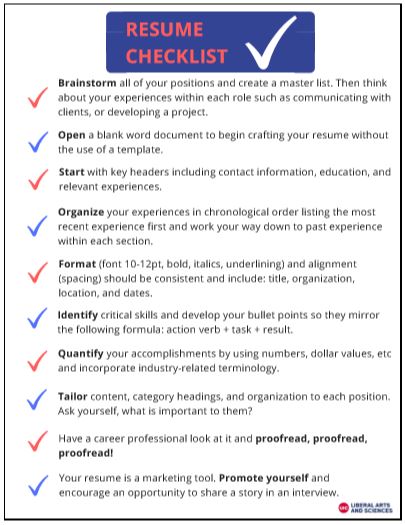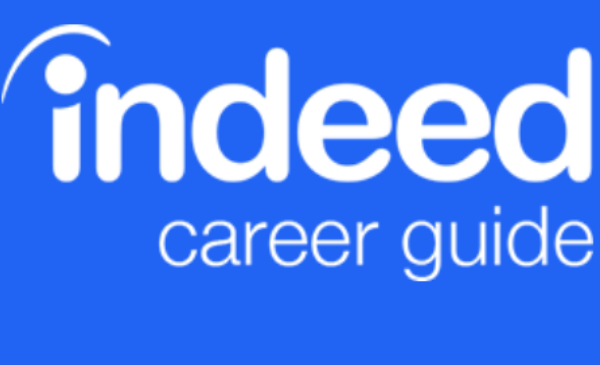Resume, Cover Letter, LinkedIn, References, Letters of Recommendation, and Interview Preparation
Build Your Professional Package Heading link

♦ Develop a strong resume and cover letter
♦ Create a LinkedIn Profile
♦ Gather a list of professional references
♦ Brush up on interview skills
Interview Video Heading link
Application Materials Heading link
The LAS Career Development Office offers support services for resume and cover letter development, interview preparation, and other application questions. Below is a guide to help you get started.
Resume Preparation Guide

Purpose: Your internship resume serves as a selling tool so you can summarize your experiences that are most relevant to a potential employer. Your goal is to produce a resume that is concise, well-ordered and communicates what you have contributed to your past employers. It will be used as talking points in your interviews.
Format:
- Name and Contact Information at the top-Include address, phone number and email address. Be sure to use a phone number where an employer can reach you. Be sure your voicemail greeting is clear and professional. Email addresses should also be professional.
- First Section is Education-Include UIC and any other college where you earned a degree.
- Reverse Chronological Format-Your experiences are listed with your most recent experiences first.
- Suggested Section Headings-Relevant Coursework, Independent Study, Internship Experience, Research Experience, Relevant Experience, Related Experience, Skills, Professional Experience, Volunteer Experience, Honors, Awards, Activities, Organizations, Involvement, and Leadership Experience
- Aesthetics-Don’t use a template and make sure to be consistent with capitalization, abbreviations, dates, and spelling. Proofread, Proofread, Proofread!
- Bullet Points-Include bullet points on your resume that serve as achievement statements to highlight your skills. They should follow this formula: ACTION VERB TASK PURPOSE
Access the list of downloads below!
Cover Letter Preparation Guide
Purpose: Your internship cover letter serves as a supplement to your resume to expand on a few of your experiences and highlight the skills you gained and how those skills align with the organization’s needs.
Format:
Your Contact Information
Date
Internship Manager Name
Manager’s Contact Information
Dear Internship Manager (Use name if available),
- First Paragraph: Introduce yourself with your name, year in school, major, and area of interest. State why you are writing, name the position or type of work for which you are applying, and mention how you heard of the opening.
- Second Paragraph: Identify 3 skills/strengths you have that will help the employer. Prove that you have each of the skills by identifying a time you used it. Explain your reasons and qualifications for desiring this type of work and how you see yourself fitting into the company.
- Third Paragraph: Explain why you are interested in working for this employer specifically. Use characteristics specific to the company to demonstrate that you have done your research.
- Fourth Paragraph: Have an appropriate closing that thanks the reader and paves the way for the interview.
Sincerely,
Sign Your Name
Type Your Name
Attachment(s): resume -or- Enclosure(s): resume
Letters of Recommendation Preparation Guide
Purpose: Letters of Recommendation are written by a faculty/advisor/supervisor/mentor to an organization outlining your strengths/abilities/qualifications for a certain job or program. A letter of recommendation is generally requested by the candidate for a particular career goal, academic application, or job opportunity.
TIP: Finding the right person depends on the program/job you are applying to. It is important that you have built a positive relationship with the person you are requesting a letter from (make sure is someone who knows you beyond 1 interaction). Consider your skills and strengths (leadership, communication, advocacy, clinical work, relator, professionalism, discipline, achiever, analytical) that will make you a good candidate for the position. Ask yourself: Who can speak specifically to how I’ve demonstrated these strengths?
Not sure you have anyone to ask? It’s time to start developing relationships! Go to office hours early in the semester, participate in discussions, turn your video on, attend events, join clubs, volunteer, intern, and be sure to stay connected by sending updates to previous faculty/supervisors/advisors who you may eventually want to ask!
How to ask?
- Give plenty of advance notice! Typically, a month before the deadline or during the early stages of the application process is what is recommended.
- Be respectful of their time and mindful that towards the end of the semester, they may be burdened by grading papers and exams as well as writing recommendations for many other students.
- Even if you are just thinking about asking someone for a letter, let them know early on in the semester about your plans.
- Try to arrange a face-to-face/virtual meeting with the potential recommender. If that’s not possible, an email exchange or phone call works well too.
- Explain clearly and succinctly what you are asking them to do such as to write a letter of recommendation for a specific job, graduate program, internship, etc.
- If you don’t know the professor or advisor well, make your connection clear in the email. For instance, you can say, “I enjoyed your class on XYZ, which I attended in fall 2019.” (Remind your professors of your grade and how you’ve previously interacted with them. Consider sending an assignment from the class that they can reference.).
- Explain why you are choosing them in particular to write the letter. Example: As my undergraduate advisor and mentor, I believe that a reference from you would provide (name of employer) with the information needed to recommend me as a (insert title of position). You’ve truly helped me over the last 3 years to identify my interests and strengths and have worked closely with me as I’ve held several internship/research/leaderships positions and can speak to my academic excellence.
TIP: Don’t take it personally if they say no. Be appreciative no matter what as to not burn bridges!
What’s next?
- Remember to say “Thank You” via email or a handwritten note to express gratitude for their time.
- Be sure to provide additional information about the process to the recommender, such as if they will need to submit the letter on a secure portal, or perhaps answer a series of questions instead of a formal letter and certainly don’t forget to include a deadline. Follow-up about 1 week before the deadline to ensure submission.
- Let your recommender know the outcome. If accepted, send another thank you and continue to keep them updated. If not accepted, you may want to schedule another conversation to discuss next steps. Keep in mind, you may want to ask them for a future letter.
Format: Ask the company, college, or program who is requiring the letter how to get the letter to them. Some companies have moved to online systems where letters have to be uploaded or written directly in their portal.
More is not always better. Typically, 2-3 letters are plenty.
References List Preparation Guide
Purpose: A list of references, is a document that a candidate creates which provides the contact information and title of around 3 professionals who can speak highly of you and recommend you to a job/internship. A list of references is likely to be asked for after you’ve made it through several rounds of the interview process and employers are trying to decide between a select number of candidates.
TIP: Finding the right person depends on the program/job you are applying to. It is important that you have built a positive relationship with the person you are requesting a reference from (make sure is someone who knows you beyond 1 interaction). Consider your skills and strengths (leadership, communication, advocacy, clinical work, relator, professionalism, discipline, achiever, analytical) that will make you a good candidate for the position. Ask yourself: Who can speak specifically to how I’ve demonstrated these strengths?
Not sure you have anyone to ask? It’s time to start developing relationships! Go to office hours early in the semester, participate in discussions, turn your video on, attend events, join clubs, volunteer, intern, and be sure to stay connected by sending updates to previous faculty/supervisors/advisors who you may eventually want to ask!
Always contact your reference first to ask permission to use them as your reference. This gives you the opportunity to tell your reference what you are pursuing and why. These individuals should be familiar with your skills and personal attributes. They should be someone who can attest to your qualifications for a particular position. Provide a copy of your resume to your reference.
After confirming your 3 references, include their contact information on a formatted document similar to the sample below. This document should be taken with you during an interview or have a PDF handy to send to an employer upon request.
Remember to say “Thank You” via email or a handwritten note to express gratitude for their time and let your recommender know the outcome. If accepted, send another thank you and continue to keep them updated. If not accepted, you may want to schedule another conversation to discuss next steps. Keep in mind, you may want to ask them to be a future reference.
Format: Use the same heading as you did for your resume and cover letter. Then title the document “References”
LinkedIn Preparation Guide
Purpose: Your LinkedIn Profile represents your professional brand and helps you establish professional connections, identify new opportunities, increase your knowledge of trends in your field, and allows you to explore companies and industries.
Format: There are several key components in your profile, so be sure to explore the LinkedIn Guide below to start creating and connecting!

